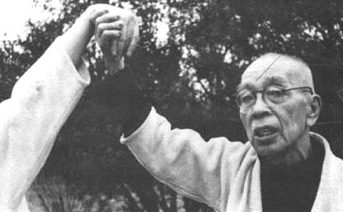My first few months lessons.
These were strange days.
I had been teaching Judo, Karate and Ju Jutsu, along with taking part in Judo and Karate competitions for years. I thought I was quite good at the various disciplines and had a good understanding of what represented the “art” in Martial Artist.
20 years study of martial arts, practising my techniques in the Dojo, teaching them or using them in competition had given me an answer to most questions and I felt reasonably comfortable with my knowledge and my ability.
It came as quite a shock when I was shown techniques I had no answer to. I had no counter, no defence and very little idea of what was going to happen next.
Everything I had ever learnt about my arts was shredded, literally before my eyes.
My first few months classes were in the foundations of Ninpo Tai Jutsu, the fundamental Kata. This concept of building good foundations is so important. Translate it into building a house, without good foundations the whole construction will fall down, very quickly.
Like 99% of everything we do throughout our life, I assumed these first techniques were “the basics”, the easy stuff. So I was even more confused when I was told no, these are the advanced techniques. My first thought was, “if this is the easy stuff, my God the advanced stuff must hurt like hell”, followed by “well that’s confusing, why start with the hard stuff”?
Even now after all these years it’s hard to explain. But I guess I should try.
These “foundation” techniques are much much more than that. They are full of lessons which help us understand every other technique. The more we understand about everything else, the more we learn about the foundations. The more we understand the foundations, the better we understand the rest, and so on for infinity.
It then becomes a self fulfilling cycle. The more we understand the more we understand. Simple eh?
Now this was back in 1985 and it turned my conventional “wisdom” upside down. The funny thing is, it makes complete, logical, sense.
The foundation techniques are taught in Kata form and Kata was nothing new to me. Every martial art has Kata, but Ninpo Tai Jutsu Kata really does have a different feel. Nothing I can put my finger on and describe, no matter how hard I try. Anyway, the purpose of these is give us a set of guidelines, tactics and lessons.
In order to be able to defend yourself well it is not enough to know a selection of techniques. To apply them correctly it is important to understand what a technique is made up of.
For example;
Balance, Timing, Positioning, Distance, Technique, Posture, Footwork.
These are only a few of the skills you will need.
The three fundamental Kata of Ninpo Tai Jutsu are Kamae no Kata, Kihon Happo and Sanshin no Kata.
These form the triangle of knowledge necessary to correctly apply your technique. Not forgetting that in a true self defence situation, you wont be applying your Dojo technique, but taking the concept of it and applying that to the situation. You have to experience it to understand it fully.
Kamae no Kata will teach positioning and posture. Kihon Happo will teach fundamental techniques. Sanshin no Kata will teach how to deliver your weight and footwork.
All techniques are made up of elements of these three Kata. For example, it is not enough to know a selection of techniques if your foot positioning is not correct.
Equally it is not enough to have good footwork but poor positioning.
Kihon Happo comprises of eight fundamental techniques and is divided into two sections. From these eight come all other techniques.
These eight techniques teach timing, distance and balance, among other things. Kamae no Kata teaches us posture, plus how and where to place our body.
Contrary to popular belief and teaching, these are not fighting postures, but positions you’ll find yourself in during the ebb and flow of a fight. Simply put, postures are for standing still, positions are places to move to.
The San Shin no Kata teaches us footwork and how to correctly apply our body to a given technique.
The five techniques of San Shin no Kata are based on the five elements.
The mental attitude attached to each of the techniques relates directly to its element.
For example; when practising Sui, water, imagine how water ebbs and flows, rises and falls. It is rarely motionless and its movements are directly related to its environment.
To fully understand the concept of relating the technique to the element, it is useful to spend some time meditating on an aspect of each element.
To say the effect these techniques had on me and how they related to my own ability and knowledge was profound would be an understatement.
These few simple techniques negated EVERYTHING I knew.
When I was told that I had been accepted for membership and these Kata would be the basis of my first grading, they became the most important thing I had ever studied.
I even integrated some of the teachings into what I was doing at my other Dojo. That’s how revolutionary, powerful, unstoppable and devastating I thought these techniques were.
I couldn’t see how they could be surpassed in martial terms.
My first grading came and went pretty quickly and the first week back in the Dojo bought yet another surprise.
“This week”, said Sensei, “We will be looking at counters to all the techniques in Kihon Happo”.
WHAT???????????? Counters to these revolutionary, powerful, unstoppable and devastating techniques????????????????
Shocked? Stunned? Devastated?
All these and more. I have never been so surprised.
Until that is I saw the counters and how simple they were.
And that’s another story…………………………………….

